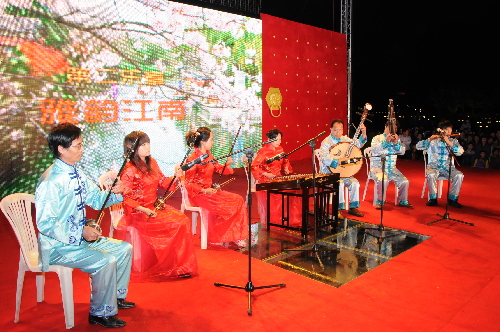Jiangnan sizhu
Jiangnan sizhu is a style of traditional Chinese instrumental music from the Jiangnan region of China.
The name Jiangnan sizhu is made up of two parts. Jiangnan is the traditional name for the area south of the lower reaches of the Yangtze river in southern Jiangsu, Shanghai, and northern Zhejiang. Sizhu, literally "silk and bamboo," refers to string and wind musical instruments, silk being the traditional material from which strings have historically been made in China, and bamboo being the material from which the Chinese flutes such as the dizi and xiao are made. The term sizhu by extension also came to refer to instrumental music in general, especially that played indoors.
Other sizhu traditions also exist, particularly along China's southeastern coastal regions of Fujian and Guangdong. Instruments typically used in Jiangnan sizhu include plucked, bowed,strummed and struck string instruments; flutes and sometimes also mouth organs; and small percussion instruments. The most commonly used instruments are:
Dizi - transverse bamboo flute, most commonly with traditional equal distant finger holes which does not produce an equal temperament, although the equal-tempered dizi is standard with professionals
Xiao - end-blown bamboo flute, as with the dizi, equal distant finger holes are preferred with the equal-tempered type standard with professionals
Erhu - two-string vertical fiddle, standard erhu D4, A4 tuning. A second erhu is sometimes used, known as fanhu (meaning "counter fiddle" or "cross fiddle"); it has thicker strings tuned a minor third (B3, F4#) or fourth (A3, E4) below the leading erhu
Pipa - pear-shaped lute with four strings, uses standard tuning of A2, D3, E3, A3. Although G2, C3, D3, G3, a whole tone lower, is sometimes used, with other string instruments also tuned a tone lower
Yangqin - hammered dulcimer, smaller than the large professional solo type, has range of two octaves and a fifth; D3 to A5
Sheng - free-reed mouth organ, most commonly with 17 pipes Sanxian - plucked lute with three strings, the small "southern" type is used, tuned to D3, A3, D4.
Qinqin - plucked lute, tuned to D3, A3, (optional 3rd string is tuned to D3) Wooden clapper (guban) and small drum (biqigu, diangu, or huaigu) Several other instruments sometimes are also used:
Zhonghu - two-string fiddle, larger and lower pitched than the erhu Ruan - plucked lute with four strings
Liuqin - small plucked lute with four strings Guzheng - plucked zither with movable bridges
Pengling – a pair of small bells As in an Irish traditional music session, the instrumentation is not fixed, and so may vary according to the musicians who are available for a particular performance. Usually only one of each instrument is used, and an ensemble can range from as few as two to as many as ten or more musicians, with the erhu, dizi or xiao, pipa, and yangqin being the core instruments. Players may sometimes switch instruments between pieces.
Eight Great PiecesAt the centre of the repertory are the Eight Great Pieces (Ba Da Qu, 八大曲) or Eight Great Famous Pieces (Ba Da Mingqu, 八大名曲):
Hua San Liu 花三六 (Huā Sān Liù, "Ornamented 'Three Six'")
Huan Le Ge 欢乐歌 (Huān Lè Gē, "Song of Joy")
Man Liu Ban 慢六板 (Màn Liù Bǎn, "Slow 'Six Beats'")
San Liu 三六 (Sān Liù, "Three Six")
Si He Ru Yi 四合如意 (Sì Hé Rú Yì, "Four Together as You Wish")
Xing Jie 行街 (Xíng Jiē, "Walking in the Street", "Wedding Procession," or "Street Procession")
Yun Qing 云庆 (Yún Qìng; "Cloud Celebration")
Zhong Hua Liu Ban 中花六板 (Zhōng Huā Liù Bǎn, "Moderately Ornamented 'Six Beats'"; also called 薰风曲 Xūn Fēng Qǔ, "Warm Breeze Tune") (Witzleben p. 61)
The repertoire is based on old melodies such as "Lao Liu Ban" (Old Six Beats), also called "Lao Ba Ban" (Old Eight Beats), which are elaborated to create new pieces such as "Zhong Hua Liu Ban" (Moderately Ornamented Six Beats), the latter of which is the most important piece of all the pieces derived from "Lao Liu Ban" (Old Six Beats) (Jones 276).
Jiangnan sizhu is generally considered to be a folk tradition rather than a professional one, and is most often performed by amateurs. It is typically performed in informal gatherings, often at tea houses. By the mid-20th century, it had also entered the curriculum of China's conservatories, where it continues to be performed by large ensembles of traditional instruments in fully scored arrangements.










